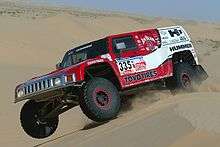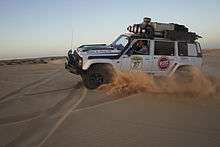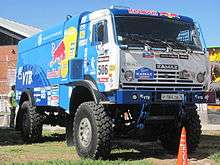Rally raid


Rally raid, also known as cross country rallying is a form of long distance off-road racing that takes place over several days.[1] Each day may require traveling up to 900 kilometres (560 mi).[1] The length of the event can be 3–15 days.[1] Examples of rally raid races include the Paris-Dakar Rally, Budapest-Bamako TransAnatolia Rally Raid, Rallye des Pharaons, Central Europe Rally, Spanish Baja, Raid De Himalaya, Klang Valley Rally Raid and Russian Baja Northern Forest.[2][1]
The first African rally raid run was the Côte-Côte Rally, first held in December 1976.[3]
While off-road Rally Raiding is dominated by the Dakar Rally, a multiple event World Cup exists, the FIA Cross Country Rally World Cup. For amateurs the Budapest-Bamako has been considered the world's largest amateur rally raid spanning two continents and 9000 kilometers. [4]
Navigation
Navigation is accomplished using a roadbook and also with GPS.[5]
Vehicles and classes
The three major competitive groups in rally raid are the motorcycle (moto) class, the car class, ranging from buggies to SUVs, and the T4 & T5 truck class.
Moto class

The Moto class is divided between three groups. Group 1 is Marathon, which are mildly modified production motorcycles, subdivided between engines of greater and less than 451 cc (28 cu in).[6] Group 2 is Super-Production bikes, which are more substantially modified than Marathon bikes, subdivided between engines of greater and less than 451 cc.[6] Group 3 for quads, subdivided between engines of greater and less than 500 cc.[6]
Popular motorcycles include those made by KTM and Yamaha because many of their bikes have finished in top positions. BMW motorcycles and Triumph have also been successful in the Dakar.
Car class—T1, T2 and Open

The car class is made up of vehicles weighing less than 3,500 kg (7,716 lb) and subdivided into several categories. The T1 Group is made up of Improved Cross Country Vehicles, such as the Mitsubishi MRX09 Racing Lancer and the T2 Group is made up of Cross Country Series Production vehicles.[7] The Open class accepts weight-qualifying vehicles, such as SCORE International trucks.[7]
Originally, European utility vehicles like the Renault 4, Land Rover, Range Rover, Mercedes-Benz G, Volkswagen Iltis and the Pinzgauer, as well the Japanese Toyota Land Cruiser, dominated the sport.
Prominent examples in the Car Class included the Mitsubishi Pajero/Montero, the Volkswagen Race Touareg, the Bowler Wildcat 200 and the Nissan Navara.
Truck class—T4 and T5

The Truck class, also known as "Camions" or "Lorries" is made up of vehicles weighing more than 3,500 kg (7,716 lb).[8] They are divided into two groups, T4 and T5.
T4 class trucks participate in the competition, while T5 trucks are rally support trucks, which means they travel from bivouac to bivouac to support other competition vehicles.[8] T4 trucks may provide assistance during the special stages, but must be homologated vehicles. The T4.1 class covers production trucks, and the T4.2 class covers modified trucks.[9] T5 vehicles do not have to be homologated.[8]
The T4 class has been composed of vehicles manufactured by Tatra, LIAZ, Volkswagen, Kamaz, Hino, Mack, Isuzu, GAZ, MAN, DAF, MAZ, Mercedes-Benz Unimog, Renault Kerax, Scania, Iveco, International and GINAF. In the 1980s, a strong rivalry between DAF and Mercedes-Benz led to vehicles which had twin engines and more than 1000 hp (750 kW). Later Tatra, and Kamaz took the race up. After 2000, renewed competition started in the truck class between DAF, Tatra, Mercedes-Benz and Kamaz.
References
- 1 2 3 4 RallyRaid
- ↑ Motorsport.com: News channel
- ↑ http://www.motorsportmemorial.org/focus.php?db=ms&n=6569
- ↑ Race Dezert http://www.race-dezert.com/home/the-trans-saharan-budapest-bamako-rally-49536.html
- ↑ http://www.rallymanagementservices.com/roadbooklexicon.pdf
- 1 2 3 http://www.dakar.com/2008/DAK/presentation/docs/DAK08_reglement_moto_us.pdf PDF (4.91 MiB)
- 1 2 http://www.dakar.com/2008/DAK/presentation/docs/DAK08_reglement_auto_us.pdf PDF (6.01 MiB)
- 1 2 3 "Dakar Dictionary".
- ↑ http://www.dakar.com/2008/DAK/presentation/docs/DAK08_fiche_vehicule_us.pdf PDF (81.6 KiB)
| ||||||||||||||